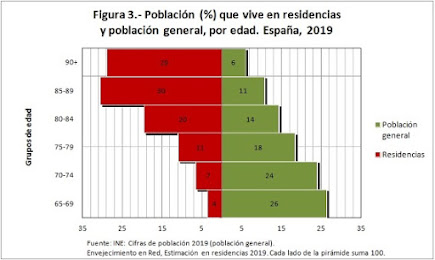Nursing homes in Spain at a glance
Although it is very difficult to know exactly how many nursing homes there are in Spain because the statistics are made from the regions. There is no doubt that it is a growing sector that in ten years (from 2008 to 2018), went from a turnover of 4,055 to 4,500 million euros and would have reached 4,800 in 2020 if it had not been for the pandemic.
Thus, according to public data, in 2019 there were 372,985 places in Spain (in 5,417 nursing homes). This is to serve a population over 65 years of age of about nine million people, which means a little more than 4 beds for every 100 people over 65 years of age.
If the 5 beds per 100 elderly people recommended by the experts are to be reached, Spain will need to build 70,000 nursing homes in the coming years.
The private nursing home sector is undergoing a process of concentration and the arrival of foreign capital. The large groups are the result of the merger of several companies. For instance, Domus Vi is made up of two large companies, Geriatricos and SARquavitae, on the other hand, Amavir was created as a result of the purchase of the Amma group by Adavir. Colisee has also added La Saleta and STS with many other shareholdings. These groups have in common their French origin.
Other key players in understanding the nursing home business are the so-called investment funds that have entered with force to buy the properties where nursing homes operate and have specialised in buying assets in operation.
Some funds have also invested in the care home managers themselves.
The arrival of investment funds has generated resistance in part from family members and employees in the sector, encouraged in part by some political parties and part of the press. The fear is that the companies, and especially the funds, will prioritise profit over quality of care, something that has not been proven to be happening. These groups propose that care homes should belong to the public sector and that the government should invest in the construction and management of care homes, something that is economically unfeasible.
In the meantime, the fact is that many places in private care homes are paid for by the regional governments through public-private partnership schemes.
According to the consultancy firm DBK: 59% of the total market corresponded in 2018 to private residences (2,655 million euros in turnover), 30.4% to private paid by the government (1,370,000 euros) and the remaining 10.6% to public ones.
This means that 65% of the places in private nursing homes are purely private (186,300) and the rest are government-funded.


Comments
Post a Comment